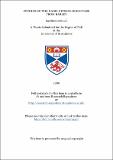Files in this item
Studies on the NADH-nitrate reductase from barley
Item metadata
| dc.contributor.advisor | Wray, John L. | |
| dc.contributor.author | Small, Ian Stewart | |
| dc.coverage.spatial | 299 p. | en_US |
| dc.date.accessioned | 2018-06-22T08:26:42Z | |
| dc.date.available | 2018-06-22T08:26:42Z | |
| dc.date.issued | 1980 | |
| dc.identifier.uri | https://hdl.handle.net/10023/14437 | |
| dc.description.abstract | The structure and properties of barley nitrate reductase (NADH ; nitrate oxidoreductase, E.C. 1.6.6.1.) have been analysed. A protocol has been established for the purification of barley nitrate reductase, involving (NH4)2SO4 fractionation, gel filtration through Biogel A1.5 m and affinity chromatography through Blue Dextran-Sepharose. This protocol should allow the preparation of homogeneous enzyme at higher yields than have hitherto been obtained, although this goal was not achieved in the work reported here. Barley nitrate reductase has been shown to have a calculated molecular weight of 203,000, based on experimentally determined values for its sedimentation coefficient (7.7 S) and Stokes radius (6.4 nm). The enzyme is highly asymmetrical with a frictional ratio of 1.65 and an axial ratio of 11:1. It can catalyse the reduction of nitrate using either NADH (the physiological electron donor), FMNH or reduced methyl viologen as electron donor and can also catalyse an NADH-dependent reduction of cytochrome c. Barley nitrate reductase is shown to break down to give rise to NADH-cytochrome c reductase species possessing molecular weights of 40 000, 61 000, and 163 000 and the levels of these species are shown to be much higher in extracts from plants older than 90 hours than in extracts (V) from 90-hour old plants. A purification procedure for the 40 000 molecular weight NADH-cytochrome c reductase species has been established and involves Blue Dextran- Sepharose affinity chromatography. Data is presented which characterises a ferrocyanide-activated NADH-cytochrome c reductase species in extracts from barley plants and shows it to be a globular protein with a molecular weight of 45 000. Evidence is presented which suggests that this species is not related to nitrate reductase. The ability of artificial electron acceptors to accept electrons from nitrate reductase in place of cytochrome c has been examined. It is concluded that although DCPIP, ferricyanide and nitroblue-tetrazolium are capable of acting as substrates for the reaction, they do so much less efficiently than cytochrome c and are much less specific than cytochrome c. The thermal stability of all the associated activities of barley nitrate reductase at 45° has been examined. Whereas the half-lives of both NADH-dependent activities were short (3-5 minutes) those of FMNH- and reduced methyl viologen nitrate reductase activities were much longer (23.5 minutes and 35 minutes respectively). Thermal inactivation of FMNH-nitrate reductase-activity was shown to be biphasic and evidence is presented which suggests that FMNH may donate electrons at two separate sites on barley nitrate reductase. Attempts were made to reconstitute nitrate reductase activity in vitro from the isolated 40 000 molecular weight NADH-cytochrome c reductase species and MCC derived from acid-treated barley nitrate reductase. These were unsuccessful. In the General Discussion, the evidence available regarding the structure of the nitrate reductases from fungal, algal and higher plant sources is reviewed and analysed. A model for the structure of higher plant nitrate reductase is presented which accounts for the data reported here and in the literature. A mechanism for the turnover of nitrate reductase in vivo is also proposed as is the probable route of genetic evolution of the nitrate reductases. | en_US |
| dc.language.iso | en | en_US |
| dc.publisher | University of St Andrews | |
| dc.subject.lcc | QP601.R3S6 | |
| dc.title | Studies on the NADH-nitrate reductase from barley | en_US |
| dc.type | Thesis | en_US |
| dc.contributor.sponsor | Biotechnology and Biological Sciences Research Council (BBSRC) | en_US |
| dc.type.qualificationlevel | Doctoral | en_US |
| dc.type.qualificationname | PhD Doctor of Philosophy | en_US |
| dc.publisher.institution | The University of St Andrews | en_US |
This item appears in the following Collection(s)
Items in the St Andrews Research Repository are protected by copyright, with all rights reserved, unless otherwise indicated.

